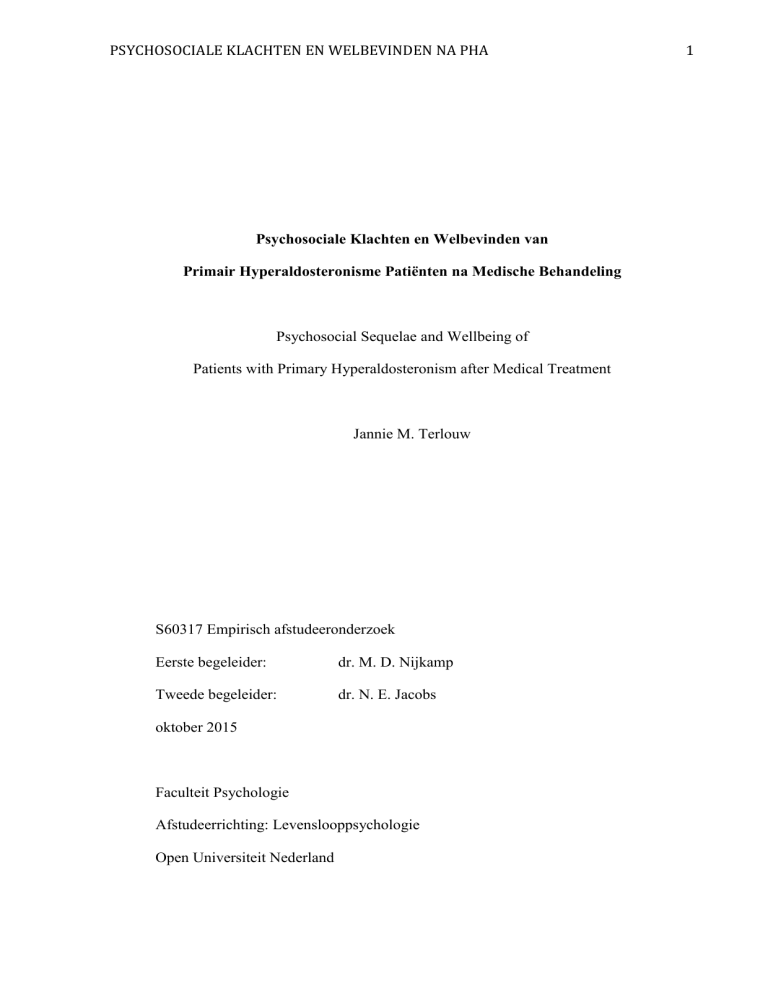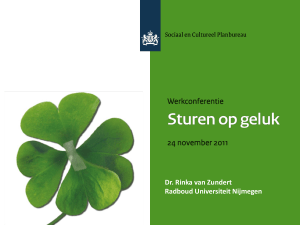
PSYCHOSOCIALE KLACHTEN EN WELBEVINDEN NA PHA
Psychosociale Klachten en Welbevinden van
Primair Hyperaldosteronisme Patiënten na Medische Behandeling
Psychosocial Sequelae and Wellbeing of
Patients with Primary Hyperaldosteronism after Medical Treatment
Jannie M. Terlouw
S60317 Empirisch afstudeeronderzoek
Eerste begeleider:
dr. M. D. Nijkamp
Tweede begeleider:
dr. N. E. Jacobs
oktober 2015
Faculteit Psychologie
Afstudeerrichting: Levenslooppsychologie
Open Universiteit Nederland
1
2
PSYCHOSOCIALE KLACHTEN EN WELBEVINDEN NA PHA
Inhoudsopgave
Samenvatting
.
.
.
.
.
.
.
.
.
3
.
.
.
.
.
.
.
.
.
5
.
.
.
.
.
.
.
.
.
7
.
.
.
.
.
.
7
.
.
.
.
.
.
8
.
.
.
.
.
.
10
PHA en psychosociale klachten
.
.
.
.
.
11
PHA en psychosociaal onderzoek
.
.
.
.
.
12
.
.
.
.
.
.
13
.
.
.
.
.
.
13
.
.
.
.
14
Abstract
.
Inleiding
Primair hyperaldosteronisme
Welbevinden
.
.
Het biopsychosociale model
Verschillen per type PHA
Andere invloeden
.
Welbevinden na behandeling voor PHA
Hypothesen
Methode
.
.
.
.
.
.
.
.
.
.
16
.
.
.
.
.
.
.
.
16
.
.
.
.
.
.
16
.
.
.
.
.
.
17
.
.
.
.
.
.
20
Design en Respondenten
Meetinstrumenten
.
Ethische verantwoording
Procedure
.
.
.
.
.
.
.
.
20
Analyse
.
.
.
.
.
.
.
.
21
Resultaten
.
.
.
.
.
.
.
.
.
23
Discussie
.
.
.
.
.
.
.
.
.
26
Referenties
.
.
.
.
.
.
.
.
.
31
.
Bijlagen
A
PHA en chronische stress
.
.
.
37
B
Onderlinge verbanden in eerdere publicaties .
.
.
38
C
Vragenlijst
.
.
.
.
.
.
39
D
Co-morbiditeit
.
.
.
.
.
.
42
E
Omgaan met vermoeidheid .
.
.
.
.
43
F
Poortwachters .
.
.
.
.
.
44
G
Wervingsbrieven
.
.
.
.
.
48
.
PSYCHOSOCIALE KLACHTEN EN WELBEVINDEN NA PHA
3
Psychosociale klachten en welbevinden van
primair hyperaldosteronisme patiënten na medische behandeling
Jannie M. Terlouw
Samenvatting
Achtergrond. Primair hyperaldosteronisme (PHA) is een steeds vaker gediagnosticeerde
oorzaak van hypertensie. De ziekte is goed te behandelen, maar er is steeds meer bewijs dat
de aandoening mentaal en emotioneel op langere termijn nog sporen nalaat met een
verminderde kwaliteit van leven.
Doel. Dit onderzoek richtte zich op psychosociale klachten en welbevinden van optimaal
medische behandelde PHA patiënten ná het eerste jaar. De twee typen PHA – adenoom
en hyperplasie – zijn met elkaar vergeleken en de invloed van sekse en co-morbiditeit is
onderzocht.
Deelnemers, procedure, onderzoeksontwerp. Via de patiëntenvereniging NVACP en het
Radboud Universitair Medisch Centrum zijn 397 patiënten benaderd, waarvan 123 de
eenmalige digitale vragenlijst hebben ingevuld. Het betrof 89 personen met adenoom en 34
met hyperplasie. De gemiddelde leeftijd was 57,45 jaar. De groep bestond voor 75% uit
mannen en voor 25% uit vrouwen. De (start van de) behandeling varieerde van 13 tot 295
maanden geleden, gemiddeld was dit 59,3 maanden.
Meetinstrumenten. De psychische klachten zijn gemeten met de subschalen voor angst, voor
depressie en voor insufficiëntie van denken en handelen van de SCL-90 (Arrindell & Ettema,
PSYCHOSOCIALE KLACHTEN EN WELBEVINDEN NA PHA
4
2003); welbevinden is gemeten met de DMHC-SF (Lamers, Westerhof, Bohlmeijer, ten
Klooster, & Keyes, 2011).
Resultaten. De resultaten toonden geen verschil tussen de twee typen PHA noch qua
psychische klachten noch qua welbevinden. Psychische klachten bleken 10,6% van de
variantie in welbevinden te verklaren (β = -.34 Adjusted R2 = .106, F (1,121) = 15.44, p <
.001). Ook na controle voor de variabelen sekse en co-morbiditeit bleek type PHA geen
invloed te hebben op psychische klachten en op welbevinden. Wel werd duidelijk dat comorbiditeit met 26,3% significant van invloed was op psychische klachten (β = .52, Adjusted
R2 = .263, F (1,121) = 44.56, p < .001).
Conclusie. Geconcludeerd is dat ten tijde van de gemiddelde vijf jaar na de behandeling geen
relatie bestaat tussen PHA en psychische klachten, noch tussen PHA en welbevinden. Er zijn
geen verschillen gevonden in psychische klachten en welbevinden tussen de patiënten met
adenoom en met hyperplasie. De scores wat betreft psychische klachten zijn voor ruim 25%
veroorzaakt door co-morbiditeit en zij bepalen het welbevinden voor ruim 10%. Aanbevolen
wordt eventuele psychische klachten in een breder kader te plaatsen. Voor ondersteuning bij
de frequent gemelde vermoeidheid wordt nader onderzoek voorgesteld. Bij vervolgonderzoek
wordt geadviseerd de tijdsperiode te limiteren.
Keywords: primair hyperaldosteronisme, psychosociale klachten, welbevinden
PSYCHOSOCIALE KLACHTEN EN WELBEVINDEN NA PHA
5
Psychosocial Sequelae and Wellbeing of
Patients with Primary Hyperaldosteronism after Medical Treatment
Jannie M. Terlouw
Abstract
Background. Primary hyperaldosteronism (PHA) is an increasingly diagnosed cause of
hypertension. The affliction can be treated effectively, but there is increasing evidence that
the affliction causes long-term mental and emotional sequelae that diminish a patient’s quality
of life.
Aim. This study discusses psychosocial symptoms and wellbeing of PHA patients who have
received optimal medical treatment at least one year ago. The effect of two types of PHA –
adenoma and hyperplasia – were compared and the influence of the variables gender and
comorbidity investigated.
Participants, procedure, design. Through the patient organisation NVACP and the Radboud
University Medical Centre a total of 397 patients were contacted, 123 of which filled out a
single digital questionnaire. There were 89 respondents for adenoma and 34 for hyperplasia.
The mean age was 57.45 years. The group consisted of 75% male and 25% female
respondents. Patients had started or completed their treatment 13 to 295 months ago, with a
mean of 59.3 months.
Measuring instruments. The psychological symptoms have been measured using the SCL-90
subscales for anxiety, depression and insufficiency (Arrindell & Ettema, 2003); wellbeing has
PSYCHOSOCIALE KLACHTEN EN WELBEVINDEN NA PHA
6
been measured using the DMHC-SF (Lamers, Westerhof, Bohlmeijer, ten Klooster, & Keyes,
2011).
Results. The results showed no discrepancy between the two types of PHA regarding either
psychological symptoms or wellbeing. Psychological symptoms did explain 10.6% of
variance in wellbeing (β = -.34 Adjusted R2 = .106, F (1,121) = 15.44, p < .001).
Even after the influence of gender and comorbidity on the PHA type had been ruled out, the
PHA type still did not appear to influence psychological symptoms or wellbeing.
It did become apparent that comorbidity influenced psychological symptoms (β = .52,
Adjusted R2 = .263, F (1,121) = 44.56, p < .001).
Conclusion. This study concludes that during the average of five years after treatment there is
neither a correlation between PHA and psychological symptoms nor between PHA and
wellbeing. The groups of patients with adenoma or hyperplasia had comparable scores for
psychological symptoms and wellbeing. Over 25% of scores for psychological symptoms
were caused by comorbidity and psychological symptoms impacted 10% of the wellbeing
scores. It is advised to place any psychological symptoms in a broader context. Further studies
are recommended to tackle the frequently mentioned symptom of fatigue. For future research
it is also advisable to restrict the study to a shorter post-treatment timeframe.
Keywords: primary hyperaldosteronism, psychosocial effects, wellbeing












